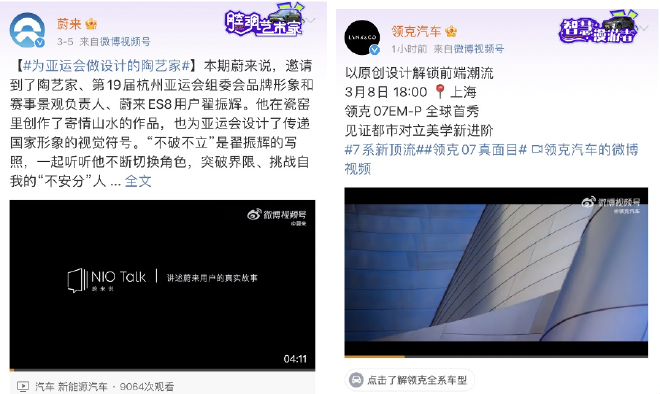The new energy vehicle industry has entered 2024 under the pressure of competition, with collective price reductions in the beginning of the year marking the start of this year’s fierce competition in the car market. The internal competition in the Chinese car market has brought about a new situation, and has also had a huge impact on the traditional media business. The traditional media’s influence has gradually been taken over by KOLs and KOCs, and car content has shifted from evaluating “engines, gearboxes, and chassis” to lively discussions about “refrigerators, TVs, and big sofas.” In this situation, the traditional annual “car of the year” evaluations by professionals seem to have less influence on the car purchasing decisions of internet users.
For social media platform Weibo, listening to the opinions of every netizen is the original intention, and how to balance the voices of KOL/KOC and ordinary users is the starting point of Weibo operation. The growth of traffic may follow a power law model, but if left unchecked, the two voices will gradually become unbalanced. The “2023 Weibo Annual Car Selection” can be called a clever “three-way balance” Weibo marketing activity, just like traditional “top bowl acrobatics”. Maximizing the spread of information is the first thing to consider. A game with only VIP players and no ordinary players has no future. Just like the “2023 Weibo Annual Car Selection” unlocking the “Weibo Annual Title” for a single model for the first time – this is no longer just a KOL selection, but a vote based on the mention of a specific configuration or application scenario of a single model by the massive users on Weibo. Although during the process, big Vs can campaign to their fans and interest users, but in the end, there is only one vote. Based on the large volume and high statistical sample of user word-of-mouth, it can more accurately reflect the opinions of the consumer market.
For example, the NIO ET5T won the “Tone Artist” award, and the Lynk & Co 08 EM-P won the “Smart Roamer” award. These titles were based on the product points that users frequently mentioned on the Weibo social platform, which helps companies find selling points that better match the interests of users. According to the rules of the Weibo platform, the unlocked title can be used for a year, giving the car model an exclusive identity in the public domain traffic on Weibo. This is like customizing a set of skins to stand out in the competition for traffic. The rules are designed to balance the issue of content and information dissemination rate in the public domain traffic on Weibo. More information is not always better, as the transmission rate of information cannot exceed the channel capacity. Balancing between reducing memory costs and more accurate and complete information implantation is necessary when giving products an “annual label” while also considering two types of demands. The third balance relates to the key internal driving force of the Weibo ecosystem, which is the balance between providing value to users and the direct revenue of the Weibo platform. This is a problem that any social media platform must face, involving the blending of short-term and long-term interests. Obtaining brand value in upstream competition Providing value to users, determines the boundary of the platform’s business model, must have a healthy bottom line of content, if full-screen hard advertising pop-ups compete for user attention, it will inevitably backfire. When automotive information is used as a primary lead generation for customer acquisition, the content will inevitably be “commercialized” after the platform atmosphere changes. Users will not immediately leave. Only after the loyalty accumulated is exhausted, will they escape. Once they leave, the platform will have no chance to repair the connection with the user. In the past, traditional car companies were more accustomed to announcing major company news and releasing new products on news platforms. After the rise of new media channels, there has been a significant change in the share of voice in the automotive brand field. New media channels have formed a significant peak effect. The nature of traditional media determines that they can emphasize lead conversion rates, but as a social media platform, if we determine the quality of operations based on conversion rates, we are on the wrong path. The essence of Weibo lies in hot topics and user discussions, these can have a full effect on the corporate image, as well as the brand’s public opinion wave, and the word-of-mouth effect formed by ordinary users due to the common experience of automotive brands. It satisfies the multi-dimensional demands of enterprises for brand marketing and product awareness. On the Weibo platform, the quality of content and its ability to reach and engage users are key indicators of the “expansiveness” of the Weibo ecosystem.
When the frequency of product releases continues to increase and price wars persist, the conversion rate of direct leads is far less important than maintaining the image of the car company. The former is a “point attack,” while the latter is “broad impact,” and the two are not in the same dimension. For example, a certain brand invests heavily in lead advertising in traditional media, trying to increase absolute conversion volume under the premise of a fixed conversion rate. They are attempting to influence customer decisions in the pre-purchase stage, similar to building a dam downstream. However, negative news about the brand’s losses, declining sales rankings, and mixed user experiences on social media platforms may accelerate the decline of the brand’s reputation, similar to problems with high-flow, high-fall midstream resources. Setting up barriers here can better address user concerns from the brand’s perspective. If brand awareness is shaken, or if it never enters the user’s field of vision, it will not be placed in the “decision-making candidate area.” Facing the risk of elimination in the qualifying stage, it is impossible to discuss the outcome of the final. Occupying the mind requires subtle influence A brand can only go so far, without losing the social media territory, and then entering the product niche market. Some founders of new forces are themselves big V with millions of fans, and there is a positive correlation between activity, controversial topics, and attention. Taking advantage of traffic, they can play jokes, make fun, and even create trending topics. Guided by these vivid examples, corporate executives have flocked to Weibo, reaching its peak last year. The benign expansion of the Weibo ecosystem naturally attracted the attention of ordinary netizens, and the gathering of companies and big V expanded the boundaries of social media together. The result is a self-circulating system of Weibo’s ecosystem, gradually established.
By 2023, there are 400 executives in the automotive industry who are active on Weibo, with 42 new executives joining in 2023. Many of these executives have large followings, such as Li Bin with 554,000 followers, He Xiaopeng with 1.262 million followers, and Li Xiang with a high of 2.324 million followers. The influence of these founders and actual controllers, deeply tied to their brands, also represents the brand’s influence. Weibo’s impact on corporate marketing is becoming increasingly evident. Many companies, including traditional automotive companies, are explicitly requiring applicants for marketing positions to have a deep understanding of the Weibo ecosystem, with some companies even creating positions specifically for Weibo operations and media research. Weibo, as a representative of social media marketing, has become a key focus for automotive marketing departments in recent years. Opinions on social media have a fixed following. Even users who do not often browse social media may participate in highly popular topics. This demand cannot be replaced by short video platforms, providing Weibo with the opportunity to “make waves.” In this context, Weibo, supported by big data, has greater room to play. However, Weibo is also attempting to establish a direct connection between products and customer awareness. This is another focus of the “Weibo Annual Car Selection” event. Although obtaining product tags is similar to unlocking rewards in a game, it intuitively conveys product points to potential customers. It is a more gentle and subtle way of conveying information, with greater infectiousness and less resistance to forced advertising viewing. Seemingly insignificant, but once users have relevant needs, tag-style memories will subconsciously emerge. The core of Weibo operations has always been content. The presentation of brand and product operations can be integrated into the content. Even just a fleeting glance may be more effective than continuous aerial bombardment.



